Leopard Tortoise Pyramiding
What is Leopard Tortoise Pyramiding?
There is a very clear and concise definition on Arizona Exotic Animal Hospital’s web site which states:
Pyramiding is the excessive upward growth of the scutes (the individual segments that make up the tortoise’s carapace or shell) that results in each segment taking on a pyramid-like shape.
On the surface it is very visible and can be spotted immediately but what you can not see is what is happening under the top lay of the carapace. Bone is raised in a conical fashion and bone density is more porous. Since this effects bone and is not just a cosmetic issue as some people may state, I feel that is does fall under category of Metabolic Bone Disease (MVD).
There are many theories as to what exactly is the cause of pyramiding in tortoises and more specifically Leopard tortoises and other ‘high domed’ tortoises such as Radiated tortoises, Indian, Burmese, Sri Lankin Stars etc as it appears more prevalent in these species. For years it was thought to be related to poor diet/nutrition more specifically high protein/low calcium and everyone in the tortoise industry seemed to run with that as the accepted cause for pyramiding in captive tortoises for decades.
With the advent of the internet, photos began to surface of wild specimens who seem to show pyramiding as well. Keep in mind this was thought to be only a captive husbandry issue and to be clear pyramiding is FAR more prevalent in captive animals than wild animals. This seemed to spark a more intense look to find answers as to the cause of tortoise pyramiding starting around 2000. Many tortoise hobbyists felt that they were providing the correct diet, exercise, UVB light, calcium/phosphorus ratios as recommended by the scientific community and other ‘experts’ yet their captive bred hatchings were still showing signs of pyramiding. There seemed to be a key element missing in the husbandry practices for captive raised hatchlings.
How to Prevent Leopard Tortoise Pyramiding
In January 2001, Richard Fife presented his theory and observations of what he felt was that missing key element that will prevent pyramiding in captive raised tortoises at the International Turtle and Tortoise Symposium in Vienna. According to Fife, his wife ran the initial experiment with Red Foot tortoise hatchlings that entailed separating clutchmates into two groups. One group was started on dry (low humidity) substrate and the second group on moist (high humidity) substrate. Every other variable between the two groups was identical diet, lighting, calcium etc. Within a few short months the differences between the shell growth of the two groups was evident. The high humidity group showed no signs of pyramiding while the low humidity group showed the typical signs of initial pyramiding. Fife felt that he had finally found his answer. Let me repeat that… high quality food source + high humidity = steady and smooth growth. At that symposium, he also learned that other tortoise breeders in Europe had started to introduce more moisture in their hatchlings enclosures as well and with similar positive results.
In 2003 another study was published by the University of Veterinarian medicine in Vienna: Influence of environmental humidity and dietary protein on pyramidal growth of carapaces in African spurred tortoises (Geochelone sulcata) Their findings also support the importance of proper humidity levels during periods of growth to prevent pyramiding.
The theory is that during dry seasons of the year high quality food sources are scares so tortoises do not experience much growth if any. So you have poor quality food sources + low humidity = minimal to no growth in the wild. Conversely during the wet seasons of the year when high quality food source are abundant i.e. new grass, weeds, leaf shoots tortoises will experience growth. So you have high humidity + good quality food = smooth shell growth in wild specimens. Furthermore hatchling and young Leopard tortoises spend most of their time out of the eyes of predators hiding under under dense bushes and shrubs and in wholes dug by other small animals. These areas make micro-climates where the humidity levels are much higher than the ambient levels reported by meteorologists in a given location within the natural range of the tortoise. In captive tortoise hatchlings they are typically indoors in controlled environment that don’t experience the natural seasons that are seen in the wild. They are raised in an open top enclosure with high powered heat lamps and as a result sucking all the moisture out of the air all the while providing the best diet, nutrition and lighting (UVB/UVA) possible. So you have steady continuous growth in a dry environment so the equation looks like this… high quality food source + low humidity = steady tortoise growth and pyramided scutes.
It has been established that higher humidity levels do play a vital role in preventing pyramiding in captive tortoises. However, this is not to minimize the importance of proper diet and nutrition which are of course key components to overall health and vitality of your Leopard tortoise. There are now thousands of real world success stories of people raising smooth Leopard tortoises yet still you can find those who down play the importance of increased levels of humidity. There main reasoning is nobody knows how much humidity is optimal for each species of tortoise and they do have a point. Most hobbyist who have had success raising pyramid free Leopard tortoise hatchlings will state above 50% is good while some advocate around 80% is ideal. Personally my enclosure has about 85% humidity in the basking area and close to 95% in the non-basking side. I also give daily warm water soaks for 30 plus minutes. You can read more details about the my general setup and care for Leopard tortoise here: Leopard Tortoise Housing Indoors. I have had good success so far and have six very smooth Leopard tortoises that are all about one year old. My other two young Leopard tortoises do have some pyramiding but that had started before I got them. One thing to note that with increased humidity you need to make sure that the coolest places in the enclosure does not drop below 80 degrees F at any point in time day or night.
Stopping Pyramiding Once it has Started
Among the many mysteries that have yet to be solved with the growth of the tortoise carapace, stopping pyramiding once it has begun is not so cut an dry. Increasing humidity along with proper diet can some times stop the new growth from coming in in a pyramid form. I bought a Leopard tortoise that weighted 50 grams and had started to pyramid. Now she weights 146 grams and all the new growth on the carapace is coming in at a much reduced angle and in time should continue to come in smooth. Keep in mind that scutes that have pyramided will never smooth out, we are just talking about only new shell growth.
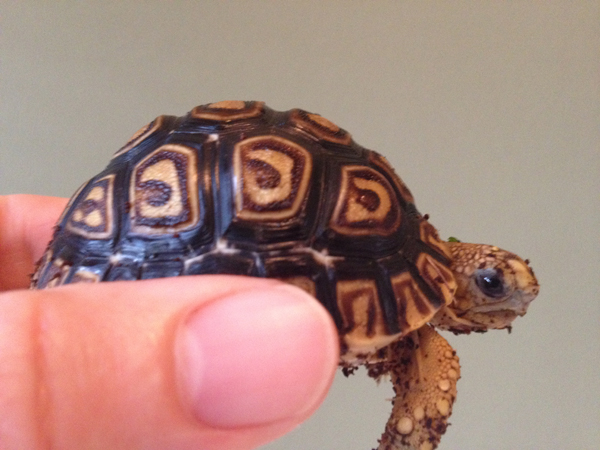
The start of pyramiding in a 50 gram Leopard tortoise
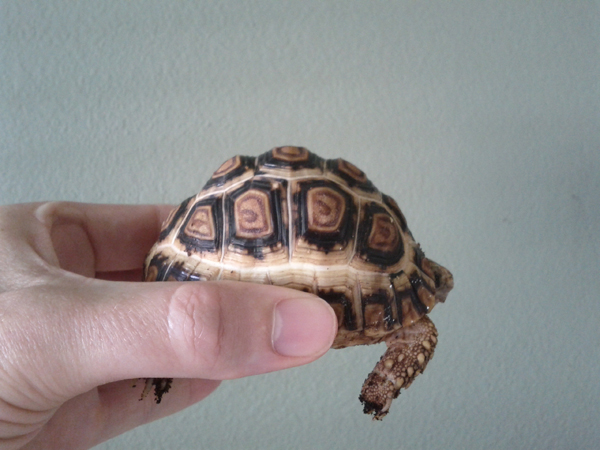
New less pyramided growth in the same Leopard tortoise now at 146 grams.
I have another Leopard tortoise that I acquired that weighed 85 grams and had also started to show signs of pyramid growth. This one has been living in the exact same enclosure as the above example but all new growth is coming in at the same angle as previous growth. So it seems in this case that there may be some window of opportunity between 40 grams and 85 grams that leads to better success of pyramid correct. Now this is of course a very small sample size but I have no other explanation at this time as to why the new scute growth of one tortoise is coming in smooth and the other is continuing at the same pyramided angle.
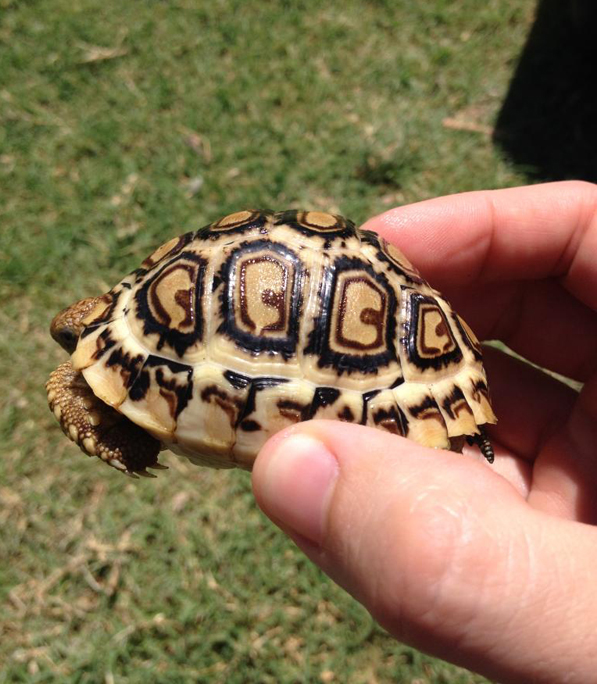
The start of pyramiding in a 85 gram Leopard tortoise
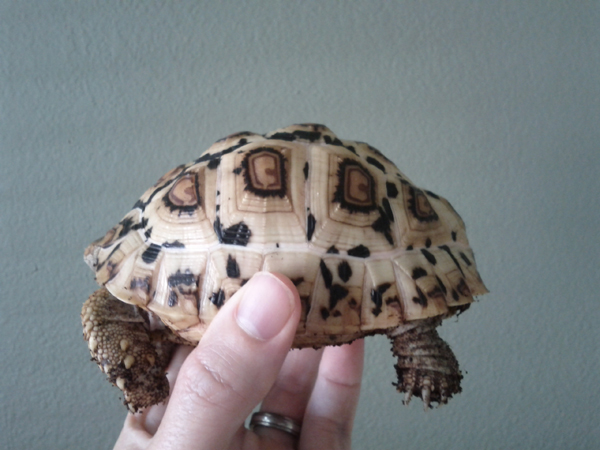
Continued pyramid growth. Note the angle between the 3rd and 4th vertebral scute in the same Leopard tortoise now at 420 grams
Myths About What Contributes to Pyramiding in Leopard Tortoises
It has been stated by some “experts” that fast growth will cause pyramiding. I disagree with this completely. Let’s look at a real world example. My fasted growing Leopard tortoise shows no signs of pyramiding and reached a weight of 500 grams and a SCL of 13 cm at one year of age. Here are three current images of that same Leopard tortoise.
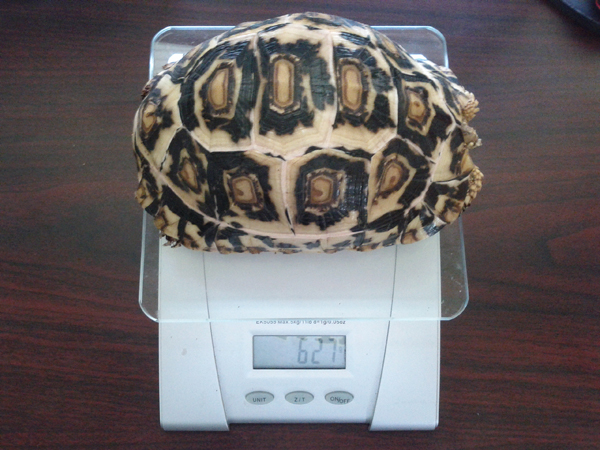
Smooth 627 gram Leopard tortoise at 13 months old
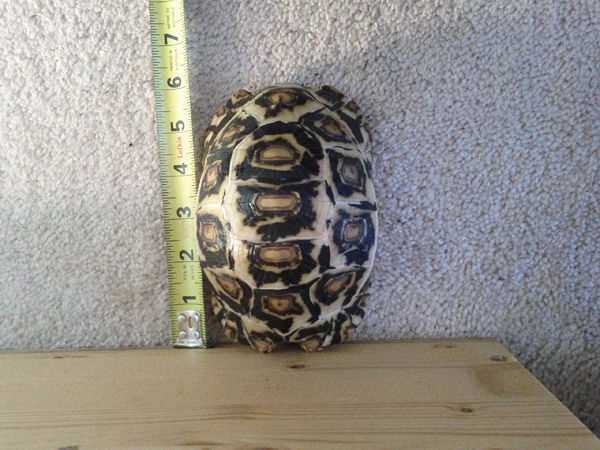
Smooth 6 inch Leopard at 13 months
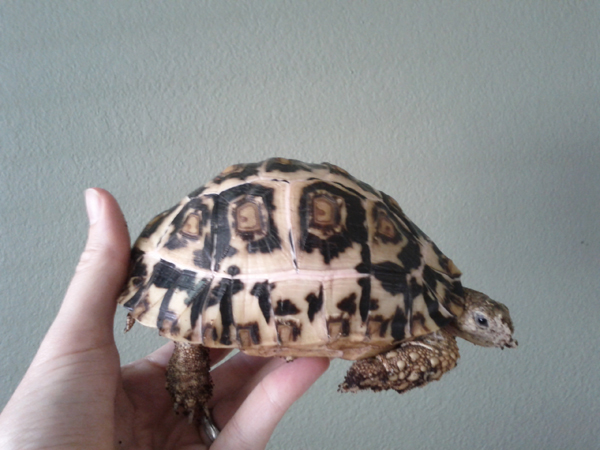
Smooth Leopard tortoise profile at 13 months
This not tremendously fast growth by this tortoise but I would say well above average compared to other hobbyist that I have spoke with and growth charts they have shared. The reason why he is not showing any signs of pyramiding even in the face of this rapid growth is simple. He has received the proper diet, exercise, exposure to UVB/UVA light and HUMIDITY in the correct amounts since hatching from an egg through the first year of life and continues to do so. I can not stress enough that proper humidity from the time of hatching has a key role in setting the growth pattern of the scutes for the life of the tortoise. I wish more breeders would take the time to at least run their own experiments on the effects of humidity with their own hatchlings so they can see with their own eyes the positive results and put an end to the needless and 100% preventable condition of pyramiding in captive Leopard tortoises.
The other myth that has been stated by some is that tortoises that are fed packaged tortoise diets like Mazuri will become pyramided. The reasoning is that it is not composed of the right ingredients for proper growth. This again has proven not the case based on my personal experiences. I feed a varied diet of weeds, grasses, leaves, greens, spring mix, romaine lettuce, Opuntia, and flowers which is about 50% of their diet the other 50% is soaked Mazuri Tortoise Diet. My Leopard tortoises seem to be growing and thriving on this feeding regimen and the specimens in my heard that had been started smooth when I acquired them have continued to grow with a very smooth carapaces.
In summary to prevent Leopard tortoise pyramiding these four elements are key: correct diet/nutrition, exercise, UVB/UVA light and humidity. When you have all these factors correct you will have a beautiful, healthy, thriving pyramid free Leopard tortoise.
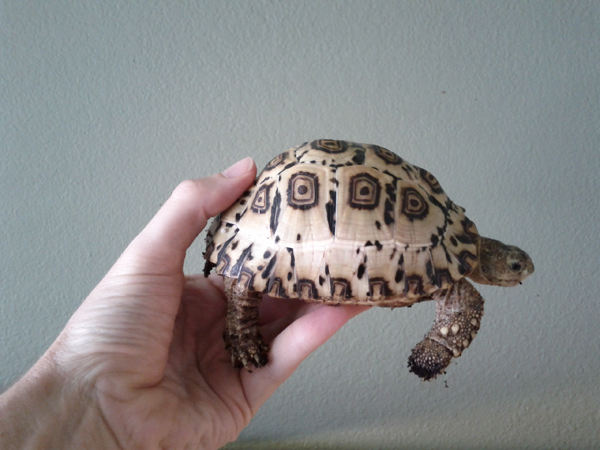
South African Leopard Tortoise at 11 months old: SCL 12 cm and Wt 400 grams
